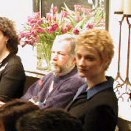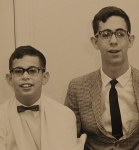danbricklin.com/log
|
||
|
|
Starting August 21, 2001
eMarker RIP, Speeches, HBR article, Experience counts, The IBM PC BIOS listing, Happy Birthday, Jonathan!
21Aug01-09Sep01
2001_08_21.htm
|
|
Sunday, September 9, 2001
eMarker RIP
Last November I wrote an essay about the Sony eMarker, a cool device for finding out the name of the song that is playing on the radio. Last week Sony sent a letter to registered users announcing that they were closing the eMarker service at the end of the month. (There is a CNet story on it.) eMarker was a very nice try by Sony. Too bad things like this can't survive yet. At least we can learn things from them, both technically and business-wise. As a very nice marketing and ethical move, they offered to take back eMarker devices people wanted to send them and give a $25 refund. (Most people paid about $20 plus tax for the original unit.)
  An eMarker ready to use, and connected to the system by USB
Speeches
I've been preparing for a couple of speeches this coming week, so I haven't had much time to write in my log. I'm also working on a long essay that will hopefully come out in the next week or two. Sorry to those who got used to more frequent posts...
Tuesday, September 4, 2001
HBR article
The September 2001 Harvard Business Review has a "first person" article entitled "Natural-Born Entrepreneur" under my byline. (Unfortunately, there isn't an online version I can point you to.) I didn't actually write the whole thing myself, but those are my words in the article. Here's how it happened: I spent a few hours talking with Harvard Business School Press editorial director Hollis Heimbouch, which she tape recorded. She then wrote up some of the parts she liked best, and then we spent additional hours in May and June getting it in a form we both liked. So...while officially I may have written it, I got lots of very professional help. Searching on Google for Hollis' name, I see that she's the one who signed for the book about Dean Kamen's secret "Ginger/IT" project, and that she edited John Seely Brown and Paul Duguid's book The Social Life of Information. Hollis and I first met at a gathering for the Hybrid Vigor Institute at Bob Metcalfe's house last February and a while later she formally proposed the article. Here's a picture I found from that night at Bob's:
 Hollis Heimbouch and Ed Belove listening to Denise Caruso in February at Bob Metcalfe's house
The article I "wrote" is quite personal, covering my feelings about being an entrepreneur, my background, dealing with hard times, etc. If you do read it, let me know what you think.
I covered the photo shoot for the accompanying picture of me back in a June 12th posting. (They ended up using a picture of me standing up holding a few of my old products.) Magazines take a long time to produce.
Monday, August 27, 2001
Experience counts
I posted a little essay that came from my noticing the strong backgrounds of the people who helped create the IBM PC. The conclusion: The IBM PC represented a revolution led by many of the old guard's troops and leaders. I believe that experience and knowledge of the past are very valuable and that the success of the IBM PC is an example of that.
Read "The Value of Experience".
Every once in a while, people extol the virtues of having inexperienced people "who aren't burdened with the baggage of knowing the old stuff" lead the way. The dotCom bubble was filled with that thinking. Good counter examples are helpful.
The IBM PC BIOS listing
During the panel at the IBM PC 20th event, moderator Brent Schlender asked me to talk about the ramifications of IBM printing a commented listing of the PC's BIOS code in their technical reference manual, since I had told him before the panel that I felt it was an important thing. I felt that the way it was presented made it clear developers should use it to learn how to work with the new machine. The book came in a purple binder (the early IBM PC software also came in similar cloth-covered binders, each with its own color). As Ray Ozzie commented in the discussion that followed, "All you needed was the PC, your external disk...and the two books, the DOS technical reference and that purple PC technical reference, and it was a sense of freedom...as a programmer." You can read what we said (more or less) in Microsoft's transcript of the panel. (Search for "important thing".)
Upon hearing about this for the first time at the event, Patrick Houston, Editorial Director of ZNet AnchorDesk, wrote a piece entitled "Why we should hail IBM's ode to open source -- the Purple Book". Many people commented on it, including some giving their remembrances from using the book.
While researching the article, he asked me in an email whether the book was the ultimate historical validation of the GPL and open source. I responded:
The "Purple Book" had a listing of a ROM. You could not change it, you could just inspect it to learn how it worked, how to interface with it, what it's bugs are, etc. That's ONE of the benefits of open source (one that the GNU people have said is very important for some time now, and is what the copy protection people want to criminalize...), but since it was a "Read-Only Memory", you couldn't make derivatives, like GPL-licensed things are expected to let you, to replace it in the same way (but you could in your code, sort of, but not for others). It does, though, speak to the importance of as much deep information for the developer as possible, which open source does give. At the event, I pointed to the "geek readability" of XML interfaces (as opposed to binary interfaces) as one of their benefits. The more information a developer has, the easier it is to get things to work properly, or soonest, or most effectively.
So, it is a partial validation -- of the part Microsoft is sort of giving in to for some developers [for "select" customers]. One reason Microsoft has been so successful has been their catering to developers in other ways, with lots of documentation, tools, working samples, etc. The more readable stuff is available to ***all*** developers, the better, if you think two guys in an attic or one kid in a dorm room may come up with the next big thing (like VisiCalc, Napster, Dell, etc.).
He then asked me what I meant by "geek readable":
By "geek readable" I meant that non-programmers may not find it any more easy to read than hexadecimal, but to a programmer (or a near-programmer) you can really see what's going on without special tools specific to that particular application. XML is readable with a normal terminal program or simple text editor. Reading binary requires you knowing the specific format for that particular binary, it can't be read by itself. It's ("geek readable") a term a few of us came up with Wed night when I said that it was "human readable" and Gates made a face -- we assumed he was reacting to the incorrect impression that it was understandable by regular people, so hopefully "geek readable" or "programmer readable" conveys what I was trying to say. Many of the Internet protocols are in simple text form, like XML but more specific to a particular task, and that has helped the growth of the Internet.
Pat edited it down (with permission) for his article.
Happy Birthday, Jonathan!
Once again, my brother Jonathan's birthday rolls around. To celebrate, here are some old pictures of the two of us together that I photographed with my digital camera at a recent family reunion. As we looked through old pictures relatives brought, I just put some of them down on a table and snapped a shot. It's a lot faster than scanning (and more portable for family events).
  My brother Jonathan and me about 35 and 29 years ago
|
||
|
© Copyright 1999-2018 by Daniel Bricklin
All Rights Reserved.
|
||